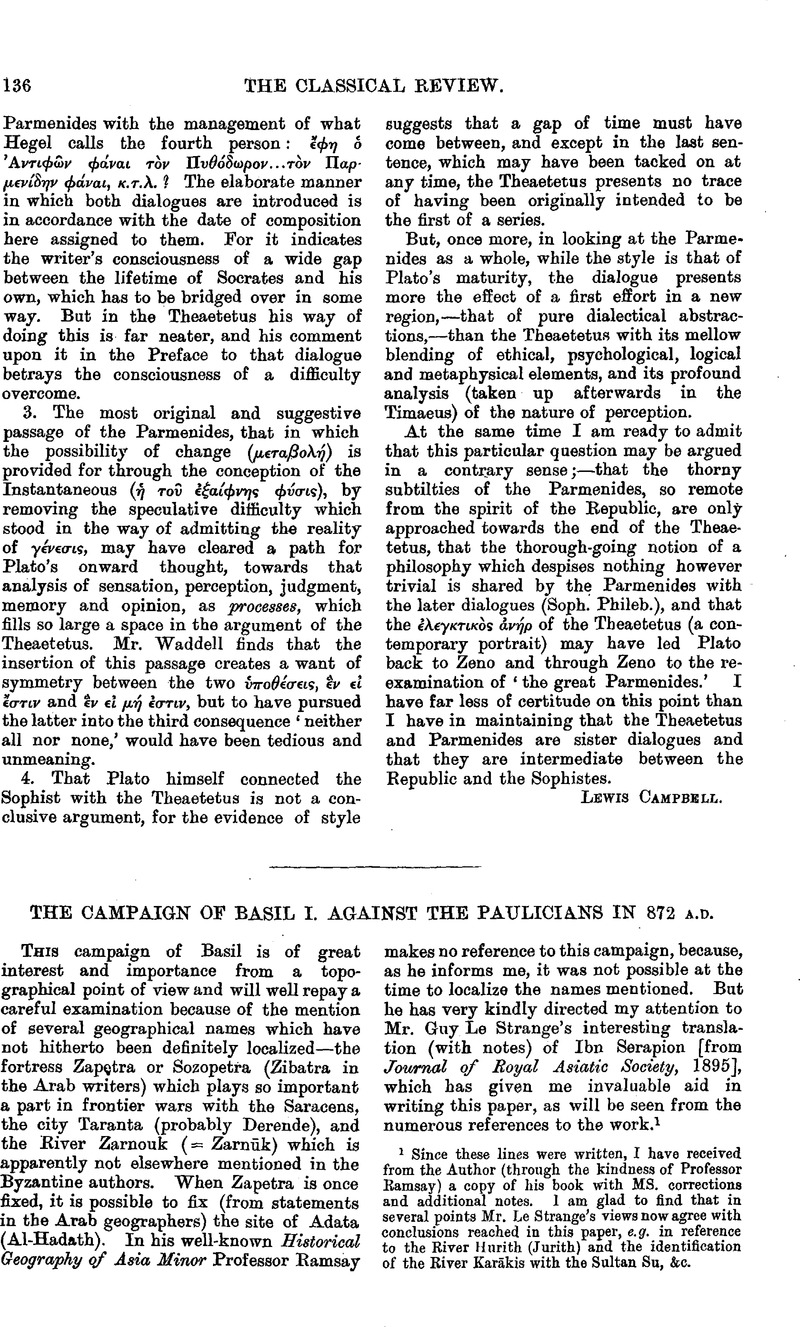Article contents
The Campaign of Basil I. Against the Paulicians in 872 a.d.
Published online by Cambridge University Press: 27 October 2009
Abstract

- Type
- Review Article
- Information
- Copyright
- Copyright © The Classical Association 1896
References
page 136 note 1 Since these lines were written, I have received from the Author (through the kindness of Professor Ramsay) a copy of his book with MS. corrections and additional notes. I am glad to find that in several points Mr. Le Strange's views now agree with conclusions reached in this paper, e.g. in reference to the River Unrith (Jurith) and the identification of the River Karākis with the Sultan Su, &c.
page 137 note 1 The Bonn edition of the Byzantine authors is quoted, unless otherwise mentioned.
page 137 note 2 Sym. Mag. (l.c.) calls the town ‘Αφρικ’, Ibn Serapion's ‘Abrik’ (Le Strange, pp. 58, 63). This form is therefore not a mere error of the MSS. but variant (see concluding paragraph). [Le Strange in his additional MS. notes proves that Abrik is Tephrikē (according to his first statement on p. 58), and not Arabkir (according to Mr. Hogarth's opinion, adopted by him on p. 740).]
page 137 note 3 Probably the Amara of Kedr. II. 154.
page 137 note 4 On Davanda I quote from his MS. additions to his Hist. Geogr.
page 137 note 5 In both passages Β∘νκ∘λιθ∘ς is the form given.
page 137 note 6 The pass Β∘υκ∘λιθ∘∘ς on this road is mentioned by Kedr. II. p. 421.
page 137 note 7 Aργαο⋯ν Kedr. II. 154.
page 137 note 8 Possibly identical with Gurun [R.].
page 138 note 1 This fact seems to be unknown to the Arab historians and is probably a mere unfounded report current in Byzantine circles.
page 138 note 2 Cf. Sir C. Wilson in his Handbook: ‘Viransheher, ruins of ancient city in the plain four miles to the left,’ i.e. west of the Marash—Malatia road. Cf. also Ritter, l.c. x. 850–1. This suggestion was made by Le Strange on Ibn Serapion, p. 65, and retracted on p. 745, in deference to Mr. Hogarth's argument. Now however he will probably recur to it again, see my first note.
page 138 note 3 Le Strange (ν. Addenda, p. 744) doubts this identification, which he had made on p. 65, in deference to Mr. Hogarth's argument that ca. 900 the whole district of Melitene was permanently occupied by the Saracens, and therefore could not be the ‘Greek country’ in which Ibn Serapion says the Karākis rises. But Ibn Serapion may have written as late as 930–40, and the Tauros range was by that time in Greek power, even Melitene being captured by Joannes Kourkouas in 934. [The translation formerly given ‘the source of the Karākis is in a lake in the Greek country’ (p. 63) is now altered to ‘in the confines of …’]
page 139 note 1 I am pleased to see that Le Strange now adds a marginal note : ‘probably the true description after all.’
page 139 note 2 The following additional references may be given. Edrisi (Weil, l.c.) says that Zibatra lay fifteen miles from Hisn Mansur (which is thirty miles from Malatia and twenty-two from Samosata—Arab miles, presumably). But Abu-1-Fida's authority is better, since he visited the place. Kudāma (Le Strange, I.c., p. 66) states that ‘from Malatia to Zibatrā was five leagues.’ The lake of Al-Hadath (cp. Weil III. p. 15) is probably the southern of the three on the course of the river.
page 139 note 3 Of course Constantine (Theoph. Cont.) may have mistaken one of the large tributaries (e.g. Tokhma Su) for the Euphrates itself.
- 3
- Cited by




